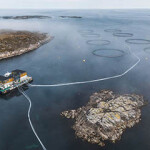Japan’s first blue shark and swordfish FIP launched

Japan’s first blue shark and swordfish fishery improvement project (FIP) has been launched by Kesennuma Distant-Water Fisheries Cooperative and Resource, Miyagi Offshore Tuna Fisheries Association, the Economics and the Policy Group at Iwate University, and Seafood Legacy. They aim to acquire Marine Stewardship Council (MSC) certification by 2026.
Kesennuma was severely damaged by the Tohoku Earthquake a decade ago, but the participating fishermen have been making an effort to recover their business. Establishing a sustainable fishery is expected to contribute to this, according to a Seafood Legacy press release.
In 2019, 2,221 metric tons (MT), or 73 percent of Japan’s total catch of 3,033 metric tons of swordfish (Xiphias gladius) was landed in Kesennuma, and its landings of blue shark (Prionace glauca) are also the highest in the country. Swordfish is sold for sashimi or for grilling, and blue sharks are used as ingredients of “hanpen” – a fluffy white fishcake.
Seafood Legacy announced the launch of the FIP on 18 March. Twelve vessels of the offshore longline tuna fleet landing their catch at Kesennuma port will participate. They operate year-round in the northwestern Pacific Ocean. The participating vessels caught 1,323 MT of swordfish and 3,706 MT of blue sharks in 2019.
According to a stock assessment conducted by the International Scientific Committee for Tuna and Tuna-Like Species, swordfish and blue sharks in the northwestern Pacific are not overfished. However, conservation, sustainability, and transparency efforts in managing shark resources, which are the cooperative's main catch target, have been ramped up worldwide and the FIP is expected to improve the fishery’s national and global reputation.
An FIP involves a pre-assessment during which deficiencies are noted. Then an action plan is prepared to close the gap. The action plan for this FIP for blue shark mainly involves advocating for establishment of a harvest strategy and harvest control rule to government and international fishery management bodies; and advocating better data collection on shark removals, including by vessels outside of the FIP. The fishery is to demonstrate that shark finning is not occurring, through observer coverage and other methods.
For swordfish, the plan calls for a robust harvest control rule that would ensure adequate stock even in the face of various uncertainties. It also calls for data collection by observers on catch of endangered, threatened, or protected (ETP) species (mainly seabirds) and secondary (non-target) species caught; and release of the data. If necessary, a management strategy for ETP species is to be developed and implemented.
For both species, the precautionary approach is to be followed in the setting of harvest levels. Sanctions for violations of catch limits or other rules are to be consistently applied and should provide an effective deterrence.
The type of fish used for bait, and their volumes and catch area, will also be recorded. If necessary, a management plan for bait species will also be implemented. The ecosystem effects of removing two apex predator and key pelagic species are also to be assessed and reported.
Photo courtesy of Seafood Legacy






Share